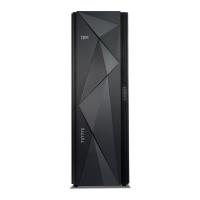August 15, 2017
© Copyright IBM Corporation, 2017 Page 28 of 117
are identified by writing export status file records for them. Refer to the Export Status File Records
section for the descriptions of the status codes.
Note: Since the logical volumes being exported are a secondary copy, the TS7700 will allow the
primary copy of a logical volume that is part of the export operation to be used for any library operation,
including mounts. If a volume is mounted and modified while the copy export operation is being
performed, the now invalid copy of the volume is still exported (assuming it was valid when the
operation began). Whether that is reflected in the database depends on the timing of the database backup
and when the volume is modified. The correct database update will be part of the next copy export
operation in this case.
• The physical volumes associated with the secondary physical volume pool that have active data on them,
are written in the TS7700 format and contain only secondary logical volume copies are locked for the
operation and cannot be used for secondary data recovery. If a physical volume is only partially full (it
has a status of filling when the operation began), its status will be changed to full as part of the copy
export operation. The locked physical volumes will be processed for export.
• Any cache-resident only logical volumes to be exported are copied to the specified pool. As the logical
volumes are copied, they are only copied to the physical volumes in the specified pool that were
‘locked’ at the beginning of the export operation. If all of those physical volumes are full, the TS7700
will use scratch physical volumes available to the pool as needed.
Any cache-resident only logical volumes that are not part of the export operation continue to be copied
to their assigned pools. For logical volumes associated with the secondary physical volume pool after
the beginning of the operation, they are copied to scratch physical volumes in the pool that are not to be
exported during the operation.
Note: If scratch physical volumes are not available for the pool when one is needed during the export
operation, the TS7700 will inform the host that it needs scratch physical volumes. If scratch physical
volumes are not supplied within 60 minutes, the export operation is terminated and the completion code
returned to the host will indicate that the export was terminated. The processed volumes remain in the
library. They are not ejected or assigned to the “Export-Hold” category.
• For each of the physical volumes in the pool that have been identified to export, the following steps are
performed one volume at a time:
The physical volume is mounted and a backup of the TS7700’s database is written to the volume. If the
database backup could not be written to a physical volume, it cannot be exported. Status file records for
all of the logical volumes on the physical volume are written indicating that the volume could not be
exported because of an exported stacked volume processing error. If the export acceleration
(LMTDBPVL) option was indicated, the backup will only be appended to the first two and the last two
volumes exported. If less than four tapes are exported all tapes will have a backup appended to the end
of the tape. These corresponding tapes containing database backup will be selected and listed in
alphabetic-order of physical tape volser. In the event that the export acceleration (LMTDBPVL) option
was set and there is a failure appending the DB backup, a different physical volume will be selected to
contain database backup so that four physical volumes have the DB backup.
• The status of the physical volume is marked as full (this is true even if the volume contains only a
small amount of active data).
• The state of the physical volume is changed to indicate that it has been copy-exported.
• Status file records are generated for the active logical volumes on the physical volume.

